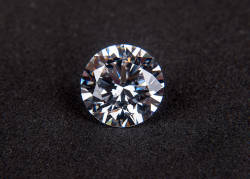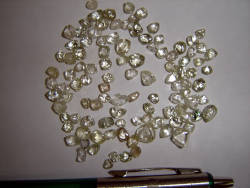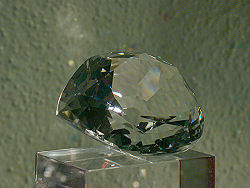Diamond Mines




Diamonds are just carbon, rather pure, common if found in the form of coal or graphite, but extremely valuable in the form of a diamond. Diamonds are different, because they consist of carbon in a very special and rare crystal grid, where the characteristics of the mineral change. It becomes a translucent crystal, the hardest rock on Earth and valuable for industrial and jewelry purposes.
The conditions to produce a diamond from plain carbon were discovered many decades ago: high pressure and high temperature, but no oxygen. Today it is possible to produce artificial diamonds by using the same environment which produced them in nature. But where did those strange conditions exist in nature? The answer is volcanic tubes called pipes deep inside earth. Those pipes, filled with lava which tried to emerge to the surface, have high pressure because of the depth and a high temperature because of the lava. If there is also carbon, diamonds are formed.
Those conditions are very rare, and so only very few deposits of diamonds exist worldwide. Most of them are concentrated on a rather small area, located in south-western Africa and eastern South America. Originally a single connected area, when the supercontinent Gonwanaland was still in one piece, 200 Mio years ago, they are now on two different continents.
The first discovery of such a diamond pipe was made in Kimberley in South Afrika. The typical rock of the pipe was called Kimberlite after this location.
The diamond mining started with several rushes around 1866, when the first diamonds were discovered near the Orange River. The first diamond found there ever is said to be the Eureka with 21.25 carat. The first years are comparable to other rushes, like the gold rush in Alaska. But soon the mining company was founded, and after some decades only De Beers remained. Today it seems, diamonds are the monopoly of one single company which controls virtually all diamonds on Earth.
Such a situation is always good to produce jealousy in the competitors, but also despotism and exorbitant prices by the monopolist. It is generally assumed that diamonds are sold at far too high prices because De Beer intervenes massively in the market and buys diamonds to artificially increase demand. In other words, the price is not justified by the rarity, it is an artificial shortage.
A common accusation against De Beers is the way the company treats its workers. Of course, they have many controls to make sure no worker steals a diamond. The workers mine valuables, worth a whole life’s work, and get only a few pennies. We cannot judge the situation of the workers, but the number of critical publications about working conditions at De Beers mines is overwhelming. So we guess a little caution is advisable when visiting one of their mines.
There is another group of diamonds which is called blood diamonds. They are mined in unstable African countries (Angola, Ivory Coast, Congo, Liberia, and others) and smuggled across borders to be sold. The money is used to buy weapons and finance terrorism, which causes bloodshed, hence the name. They are also called conflict diamonds, brown diamonds, hot diamonds, or red diamonds.
The problem exists, was handled in 1998 by the United Nations, and in 2000 the Kimberley Process Certification Scheme was introduced. The results are not very satisfactory. Diamonds are simply too easy to smuggle, due to their small size. Also, corrupt government officials are a big problem. And finally, Russia undermines the efforts by exercising its veto power as a member of the Kimberley Process because Russia itself profits from the trade in blood diamonds.
The following list is the complete list of diamond mines listed on showcaves.com. There are only eight, three of them have been closed lately, one is in Russia, and one is actually not a mine, it’s an abandoned mining town of the Germans in Namibia. In other words, visiting a diamond mine is almost as difficult as buying one is expensive. And also: four of the mines are in South Africa, and owned by De Beers.
- Examples
 Argyle Diamond Mine, Australia
Argyle Diamond Mine, Australia Sperrgebiet National Park, Namibia
Sperrgebiet National Park, Namibia Mir Diamond Mine, Russia
Mir Diamond Mine, Russia Crater of Diamonds State Park, U.S.A.
Crater of Diamonds State Park, U.S.A. Bultfontein Mine, South Africa
Bultfontein Mine, South Africa Cullinan Mine, South Africa
Cullinan Mine, South Africa Jagersfontein Mine, South Africa
Jagersfontein Mine, South Africa Kimberley Mine - Big Hole, South Africa
Kimberley Mine - Big Hole, South Africa
 Search DuckDuckGo for "Diamond Mine"
Search DuckDuckGo for "Diamond Mine" Diamond - Wikipedia (visited: 08-DEC-2023)
Diamond - Wikipedia (visited: 08-DEC-2023) De Beers Group (visited: 08-DEC-2023)
De Beers Group (visited: 08-DEC-2023)
 Index
Index Topics
Topics Hierarchical
Hierarchical Countries
Countries Maps
Maps